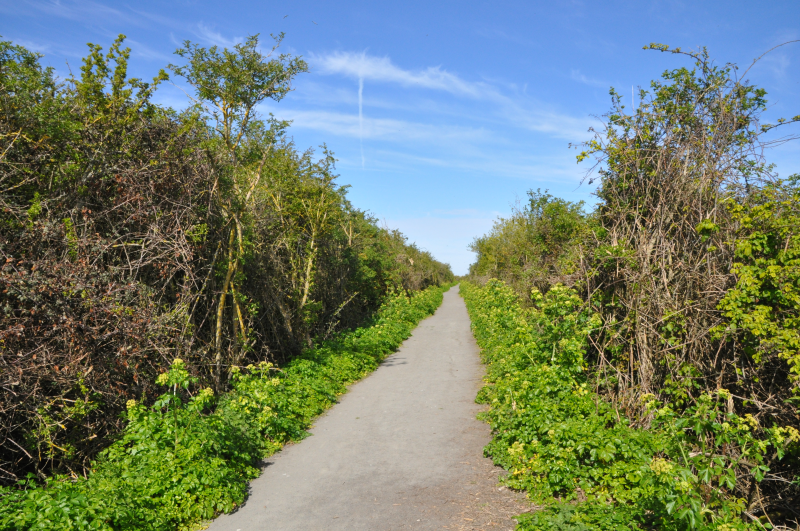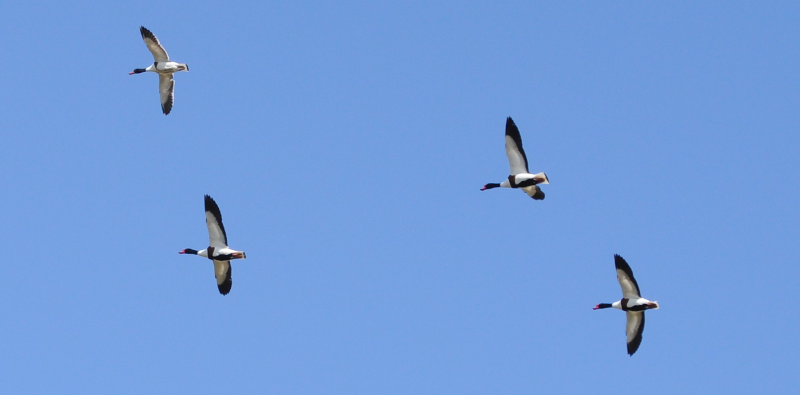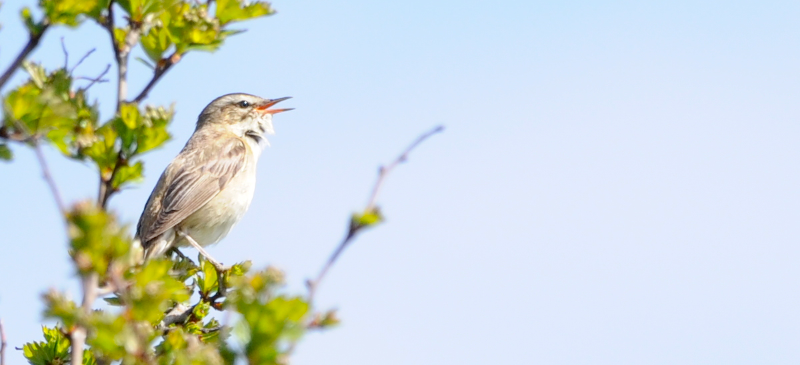Average Birding

Birds with Friends #1: Cliffe Pools and Northward Hill RSPB
We've planned a series of three little trips where we think we know roughly enough about a particular site to be able to give a meaningful tour to some enthusiastic but green birding friends.
Our first trip is to the Isle of Grain - we're off to Cliffe Pools RSPB to try to find Nightingale (amongst other things). On the assumption that we inevitably fail to find a Nightingale at Cliffe, we've a backup plan of a little walk around nearby Northward Hill RSPB.
Rehearsal
We go for a dry-run of the trip the Sunday before, and it goes...sort of OK, such that when it comes to the Friday with actual friends, turning up we're nervous, but confident; we should hopefully be able to deliver most of the birds the programme promised.
Cliffe Pools RSPB
On the day, we're up considerably earlier than the dry-run, and this causes amusing strife between AB1 (driving) and AB2 (instructing Google to navigate to a place on the reserve which is inaccessible to cars). After some minor wrangling, we're still fifteen minutes early; and brilliantly our guests are fifteen minutes late.
This does give us a bit of time to orientate ourselves. We realise that the gate to the RSPB parking is open (it wasn't on rehearsal day), so we mosey on down there, because it's...a nice place to park?
This is a good decision, because as soon as we're out of the car we can hear a Nightingale - it's perhaps thirty or forty metres North-East of us. We're pretty confident we'll walk past it once we start out on a circuit of the reserve; here's hoping it can hang on until our friends arrive!
Which they do, after a brief false start where they visit Nationwide Platforms. We cut short the introduction to the reserve in favour of going to find this Nightingale. It is belting its song out from a bushy thicket perhaps two or three metres from the path - we get right next to the sound and can't believe we're unable to see the bird.
I explain that this is standard Nightingale behaviour - the skulky little sods always sound like they ought to be visible, but they often aren't, singing from impossibly opaque brambles that permit no viewing. This bird decides to prove me wrong though, exiting its bush stage left at speed, giving us our first look at the famously rufous Nightingale behind. Well, that's a good start - I only saw my first Nightingale in 2018, and now this lot are picking one up on their first proper birding outing!

We trundle around the boundary of the reserve (also the boundary of Nationwide platforms) until we reach the point where the Saxon Shore Way meets it. There, we turn left - the path splits the reserve neatly in two, heading between the Radar and Crystal Pools.
We make a brief stop on the right-hand side of this path to examine the gull colony - picking out a Mediterranean Gull or two on the ground (we've already pointed at the sky when we've heard its distinctive barking call). We also point out a couple of larger gulls - some Herring Gulls, and a singular Lesser Black-backed Gull for completeness. We explain that the nice glossy black head of the Mediterranean Gull is worth being able to tell apart from the frankly more chocolatey brown head of Black-headed Gull.

We move on down the causeway, discovering Dunnocks in the brambles, and a duo of Great-crested Grebe pair-bonding off to the right. As we come to the transition between the Radar Pool and the Flamingo Pool (named for...what precisely?), we slow our pace a little - the scrubby brambly stuff gets a bit wider here, and this is exactly where I've found Nightingale in the past.
Somewhat unbelievably, mere seconds after we stop to listen, the unmistakable sound of Nightingale invades our ears. It's somewhere off to our left, but again, invisible...until I take a few side steps right, and suddenly the bird is obvious, sitting in a thin tree at the back of the scrub. I quickly summon everyone else to stand where I am, so they can see it, and all but one of us manages to actually do so.
I'm somewhat tickled at this point - in the test run we only picked up Nightingale at the last moment at Northward Hill, and we've found two in under an hour... we're at risk of making this birding lark look a little easy at this point. Bemused, we plough on, uncertain as to how to make the rest of the day as good as the start.

Thankfully, the birds are willing to lend a hand. As we get towards the end of the causeway, a Sedge Warbler starts bouncing up and down out of the trees on the right, flycatching. Lovely. Nearby, a shouty Cetti's Warbler gives us the opportunity to explain its noisy invisibility. A scratchy Whitethroat makes its way along the left hand side of the path; a distant singing Chiff-chaff is found to join up its song with its appearance.


Exiting the causeway and heading on to the path towards the Thames, we find a collection of sleeping Shelduck on the mud on the far side of the Flamingo pool. Also over there are thirty or forty dozy Avocets. One or two are poking about though, and we get the telescope set up so we can all have a good look at them. Two or three groups of Avocet also manage a timely fly-by while we do.

We also get a bonus Black-tailed Godwit (totally absent during the dry-run; we're just a tad late to see more of them at this point, they're on their way to breed back in Iceland) and some seriously distant Redshank. After promising that we really were done at this point, a couple of Lapwings pop up and are just too gorgeous to ignore - their breeding plumage with its petroleum shine is irresistible.
We're just tearing ourselves away from the sandy end of the Flamingo Pool when every bird on it goes absolutely bonkers - all the Avocet and Shelduck are suddenly very awake; quite a lot of them are in the air, the previously placid Lapwing are making their bizarre electronic squeaks as they battle with an imagined predator - oh, no, for once, there is actually a predator - a Peregrine Falcon making its way across the reserve. It doesn't seem imminently interested in eating anything that it's frightened and calmly carves off into the distance.

We finally make our way to the Thames (AB1 apparently completely misses the passage of a tiny grass snake across the path), accompanied by our first Linnets of the day. We briefly crest the sea wall, get blown about by a pretty aggressive Easterly wind and quickly descend back into its lea to eat a snack.

Further along the wall, we pick up Sedge Warbler #2 in a bush - exactly the same bush we found it in during the dry run - rehearsing is always worth it, kids. As a bonus, we also get a Nightingale singing in the denser scrub behind it. I've not heard them all the way out here; interesting. We don't manage to clap eyes on it - a pair of Chaffinches briefly pretend to be it, but we're not falling for it.

Onward, directly into the wind, with several stops where a larger bush, tree or shrub provides a bit of shelter. AB1 accidentally builds a bit of a lead and catches a brief sighting of a Cuckoo's backside. This is widely disbelieved, probably correctly - it was a very brief view.
As the reedbed grows in height to the right of this path, so does the scratchy clamour of a Reed Warbler's song. Once again, a reliable bird, found in (or under) the same bush as during the dry run. We eye up the first viewpoint for lunch, but decide that the next one along might be better.

Hunger drives us to that point speedily, and we find, to collective relief, an area of grass just below the viewpoint that has all of the sunlight and none of the wind. It also has excellent nearby frogs! We eat some sandwiches and catch up on some non-bird related events. There's a smattering of ducks around that we should probably get the scope on, but we decide that the relative attractions of Gadwall and Shoveler are potentially overkill after three hours of everything being very new. We do get another fly-by from our previous Godwit though.

An unbelievably tanned birder has taken up residence on the viewpoint's bench with a scope and has been keeping a close eye on things. "Anything of note?" he asks as we pass. We give an account of our birding day so far, and have most of it confirmed back to us. In addition to our count, this chap's also seen two Cuckoos (as opposed to just the behind of one).
We complete our circuit, briefly taking in the pinnacle viewpoint (it's hard to choose between the view of the reserve and Nationwide platforms) and a few showy Blackcaps mucking about in the brambles.

Well. Not bad. Not bad at all.
Northward Hill RSPB
With the motivation for this extra stop now somewhat nullified, we can now have a trundle around the woodland trail there with no pressure to find anything in particular. "This is now much more about having a nice walk, with the opportunity of a bird or two, rather than a birding mission" we say. A singing Cuckoo off to our right threatens to make this statement immediately false, but it's so far off that mounting a search for it is an immediate non-starter.
We run into a Green Woodpecker as we reach the Sweeney viewpoint (which is, it must be said, a better viewpoint than we deserve for immediately singing The Sweeney theme tune at it (particularly when the only lyrics we know are "The Sweeney, The Sweeney" etc.)). Numerous Dunnocks and Linnets hop and skip between the bushes.
We head up towards the woodland viewpoint; there's a Nightingale bubbling away some distance to our left. We try following a little path in that direction but it goes nowhere, and the singing stops. Ok, can't win 'em all, back we go (one of us still quietly humming the theme from The Sweeney).

As we climb the hill past the viewpoint, we come across another birder who is staring deeply into the trees in the direction of...yes, another singing Nightingale. We briefly exchange general birder small-talk "well, that's an unmistakable song" before going our separate ways.
At the top of the hill we're surrounded by the usual suspects; singing Blue and Great Tits, and more Chiffchaffs too. We also find some dappled bluebell pastures and some gnarly, charming, and apparently climbable old trees.

The remainder of the woodland circuit is not entirely without event - we manage to continually disturb a yaffling Green Woodpecker. Further around we hear a Great Spotted Woodpecker drumming on a hollow tree; it moves off before we can get a proper bead on it though. As we link back up to the part of the loop we originally climbed, we hear yet another Nightingale. That's the sixth, and we saw two. Mad.
We descend the hill back to the car park, and, barring an extended debrief in a nearby pub, are done for the day.